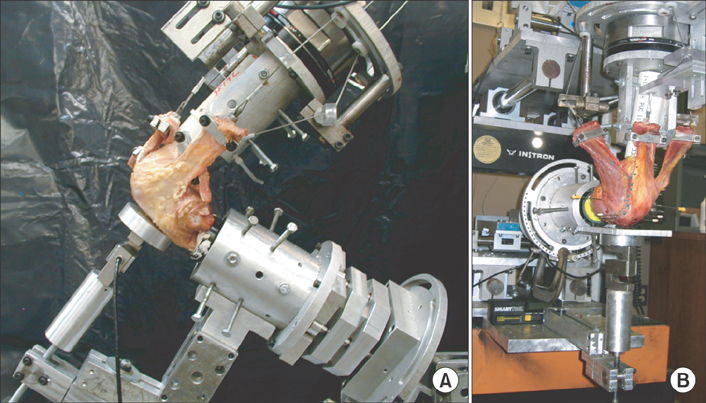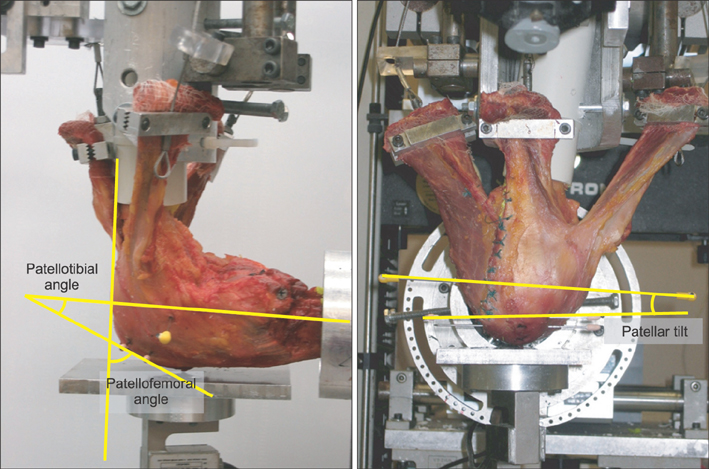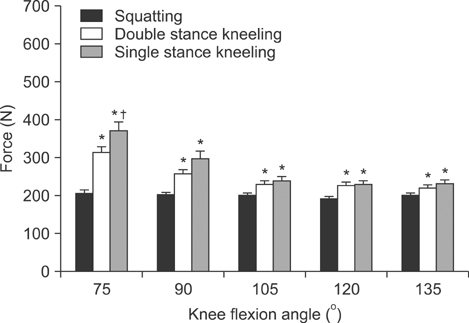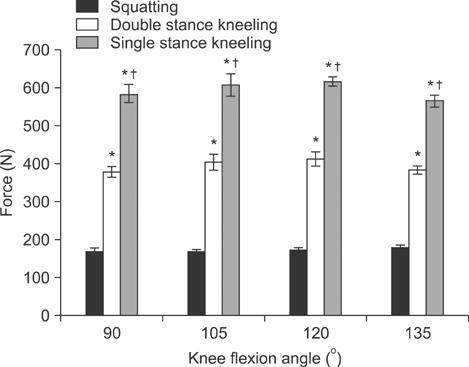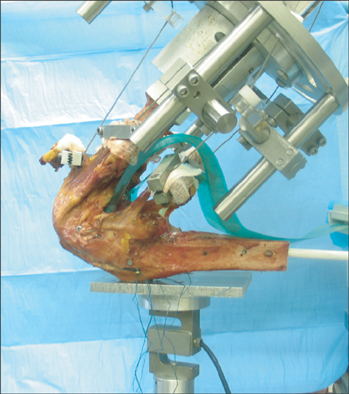Clin Orthop Surg.
2014 Jun;6(2):117-126. 10.4055/cios.2014.6.2.117.
Biomechanics of Hyperflexion and Kneeling before and after Total Knee Arthroplasty
- Affiliations
-
- 1Orthopaedic Biomechanics Laboratory, VA Long Beach Healthcare System, Long Beach and Department of Orthopaedic Surgery, University of California, Irvine, CA, USA. tqlee@med.va.gov
- KMID: 1784656
- DOI: http://doi.org/10.4055/cios.2014.6.2.117
Abstract
- The capacity to perform certain activities is frequently compromised after total knee arthroplasty (TKA) due to a functional decline resulting from decreased range of motion and a diminished ability to kneel. In this manuscript, the current biomechanical understanding of hyperflexion and kneeling before and after TKA will be discussed. Patellofemoral and tibiofemoral joint contact area, contact pressure, and kinematics were evaluated in cadaveric studies using a Tekscan pressure measuring system and Microscribe. Testing was performed on intact knees and following cruciate retaining and posterior stabilized TKA at knee flexion angles of 90degrees, 105degrees, 120degrees, and 135degrees. Three loading conditions were used to simulate squatting, double stance kneeling, and single stance kneeling. Following TKA with double stance kneeling, patellofemoral contact areas did not increase significantly at high knee flexion angle (135degrees). Kneeling resulted in tibial posterior translation and external rotation at all flexion angles. Moving from double to single stance kneeling tended to increase pressures in the cruciate retaining group, but decreased pressures in the posterior stabilized group. The cruciate retaining group had significantly larger contact areas than the posterior stabilized group, although no significant differences in pressures were observed comparing the two TKA designs (p < 0.05). If greater than 120degrees of postoperative knee range of motion can be achieved following TKA, then kneeling may be performed with less risk in the patellofemoral joint than was previously believed to be the case. However, kneeling may increase the likelihood of damage to cartilage and menisci in intact knees and after TKA increases in tibiofemoral contact area and pressures may lead to polyethyelene wear if performed on a chronic, repetitive basis.
Keyword
MeSH Terms
Figure
Reference
-
1. Daluga D, Lombardi AV Jr, Mallory TH, Vaughn BK. Knee manipulation following total knee arthroplasty: analysis of prognostic variables. J Arthroplasty. 1991; 6(2):119–128.2. Fox JL, Poss R. The role of manipulation following total knee replacement. J Bone Joint Surg Am. 1981; 63(3):357–362.3. Robinson RP, Simonian PT, McCann KJ. Rehabilitation following total knee arthroplasty. In : Fu F, Harner C, Vince K, editors. Knee surgery. Baltimore: Williams & Wilkins;1994. p. 1414–1416.4. Ritter MA, Stringer EA. Predictive range of motion after total knee replacement. Clin Orthop Relat Res. 1979; (143):115–119.5. Cummings JF, Carpenter CW, Grood ES, Leach DU, Manley MT. Joint line elevation of a total knee replacement results in reduction of knee flexion. In : Transactions of the 36th Annual Meeting of the Orthopaedic Research Society; 1990 Feb 5-8; New Orleans, LA.6. Holtgrewe J, Haynes DW, Hungerford DS. The effect of prosthetic patella thickness and anterior femoral surface on limiting flexion in total knee arthroplasty. In : Transactions of the 35th Annual Meeting of the Orthopaedic Research Society; Las Vegas, NV. 1989.7. Oglesby JW, Wilson FC. The evolution of knee arthroplasty: results with three generations of prostheses. Clin Orthop Relat Res. 1984; (186):96–103.8. Dodd CA, Hungerford DS, Krackow KA. Total knee arthroplasty fixation: comparison of the early results of paired cemented versus uncemented porous coated anatomic knee prostheses. Clin Orthop Relat Res. 1990; (260):66–70.9. Mont MA, Yoon TR, Krackow KA, Hungerford DS. Eliminating patellofemoral complications in total knee arthroplasty: clinical and radiographic results of 121 consecutive cases using the Duracon system. J Arthroplasty. 1999; 14(4):446–455.10. Adalberth G, Nilsson KG, Bystrom S, Kolstad K, Milbrink J. Low-conforming all-polyethylene tibial component not inferior to metal-backed component in cemented total knee arthroplasty: prospective, randomized radiostereometric analysis study of the AGC total knee prosthesis. J Arthroplasty. 2000; 15(6):783–792.11. Dennis DA, Haas B, Komistek RD, Brumley JT, Dennis T. Range of motion of posteior cruciate substituting total knee arthroplasty: the effect of bearing mobility. In : 68th Annual Meeting American Academy of Orthopaedic Surgeons; 2001 Feb 28-Mar 4; San Francisco, CA.12. Kanekasu K, Banks SA, Honjo S, Nakata O, Kato H. Fluoroscopic analysis of knee arthroplasty kinematics during deep flexion kneeling. J Arthroplasty. 2004; 19(8):998–1003.13. Thun M, Tanaka S, Smith AB, et al. Morbidity from repetitive knee trauma in carpet and floor layers. Br J Ind Med. 1987; 44(9):611–620.14. Kivimaki J. Occupationally related ultrasonic findings in carpet and floor layers' knees. Scand J Work Environ Health. 1992; 18(6):400–402.15. Kivimaki J, Riihimaki H, Alaranta H. Knee disorders in carpet and floor layers and painters. Part I. Isometric knee extension and flexion torques. Scand J Rehabil Med. 1994; 26(2):91–95.16. Kivimaki J, Riihimaki H, Hanninen K. Knee disorders in carpet and floor layers and painters. Scand J Work Environ Health. 1992; 18(5):310–316.17. Coggon D, Croft P, Kellingray S, Barrett D, McLaren M, Cooper C. Occupational physical activities and osteoarthritis of the knee. Arthritis Rheum. 2000; 43(7):1443–1449.18. Cooper C, McAlindon T, Coggon D, Egger P, Dieppe P. Occupational activity and osteoarthritis of the knee. Ann Rheum Dis. 1994; 53(2):90–93.19. Jensen LK, Eenberg W. Occupation as a risk factor for knee disorders. Scand J Work Environ Health. 1996; 22(3):165–175.20. Hefzy MS, Kelly BP, Cooke TD. Kinematics of the knee joint in deep flexion: a radiographic assessment. Med Eng Phys. 1998; 20(4):302–307.21. Hefzy MS, Kelly BP, Cooke TD, al-Baddah AM, Harrison L. Knee kinematics in-vivo of kneeling in deep flexion examined by bi-planar radiographs. Biomed Sci Instrum. 1997; 33:453–458.22. Schai PA, Gibbon AJ, Scott RD. Kneeling ability after total knee arthroplasty: perception and reality. Clin Orthop Relat Res. 1999; (367):195–200.23. Weiss JM, Noble PC, Conditt MA, et al. What functional activities are important to patients with knee replacements? Clin Orthop Relat Res. 2002; (404):172–188.24. Hassaballa M, Vale T, Weeg N, Hardy JR. Kneeling requirements and arthroplasty surgery. Knee. 2002; 9(4):317–319.25. Palmer SH, Servant CT, Maguire J, Parish EN, Cross MJ. Ability to kneel after total knee replacement. J Bone Joint Surg Br. 2002; 84(2):220–222.26. Coughlin KM, Incavo SJ, Doohen RR, Gamada K, Banks S, Beynnon BD. Kneeling kinematics after total knee arthroplasty: anterior-posterior contact position of a standard and a high-flex tibial insert design. J Arthroplasty. 2007; 22(2):160–165.27. Incavo SJ, Mullins ER, Coughlin KM, Banks S, Banks A, Beynnon BD. Tibiofemoral kinematic analysis of kneeling after total knee arthroplasty. J Arthroplasty. 2004; 19(7):906–910.28. Komistek RD, Scott RD, Dennis DA, Yasgur D, Anderson DT, Hajner ME. In vivo comparison of femorotibial contact positions for press-fit posterior stabilized and posterior cruciate-retaining total knee arthroplasties. J Arthroplasty. 2002; 17(2):209–216.29. Bingenheimer E, McGarry MH, Lee TQ. Biomechanical effects of kneeling on the patellofemoral joint. In : Transactions of the 51st Annual Meeting of the Orthopaedic Research Society; 2005 Feb 20-23; Washington, DC.30. Wilkens KJ, Duong LV, McGarry MH, Kim WC, Lee TQ. Biomechanical effects of kneeling after total knee arthroplasty. J Bone Joint Surg Am. 2007; 89(12):2745–2751.31. Powers CM, Lilley JC, Lee TQ. The effects of axial and multi-plane loading of the extensor mechanism on the patellofemoral joint. Clin Biomech (Bristol, Avon). 1998; 13(8):616–624.32. Wickiewicz TL, Roy RR, Powell PL, Edgerton VR. Muscle architecture of the human lower limb. Clin Orthop Relat Res. 1983; (179):275–283.33. Hofer JK, Gejo R, McGarry MH, Lee TQ. Effects on tibiofemoral biomechanics from kneeling. Clin Biomech (Bristol, Avon). 2011; 26(6):605–611.34. Hofer JK, Gejo R, McGarry MH, Lee TQ. Effects of kneeling on tibiofemoral contact pressure and area in posterior cruciate-retaining and posterior cruciate-sacrificing total knee arthroplasty. J Arthroplasty. 2012; 27(4):620–624.
- Full Text Links
- Actions
-
Cited
- CITED
-
- Close
- Share
- Similar articles
-
- In Vivo Biomechanics Using Dual Orthogonal Fluoroscopy after Posterior Stabilized Total Knee Arthroplasty
- High-Flexion Posterior-Stabilized Total Knee Prosthesis: Is It Worth the Hype?
- The evloution of total knee and hip joint arthroplasty
- Functional Evaluation of High-Flex Total Knee Arthroplasty
- The Current State of Total Shoulder Arthroplasty

